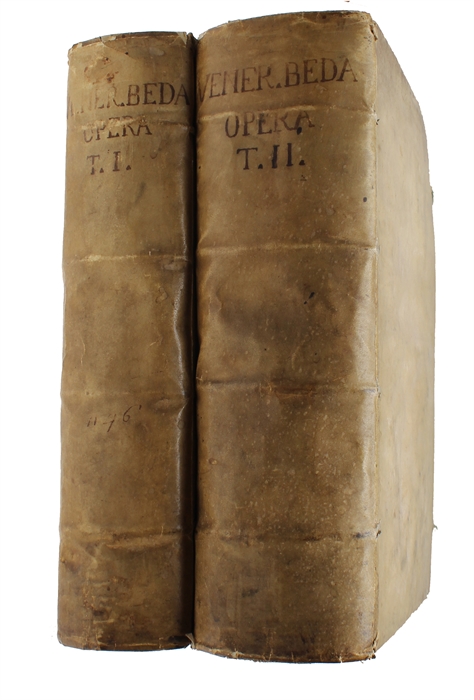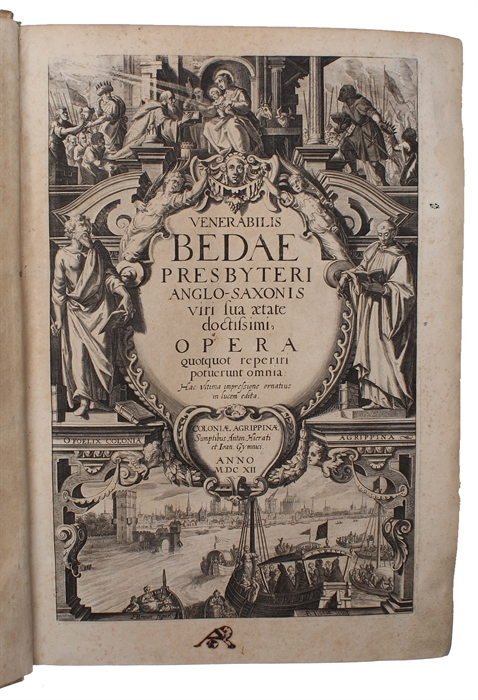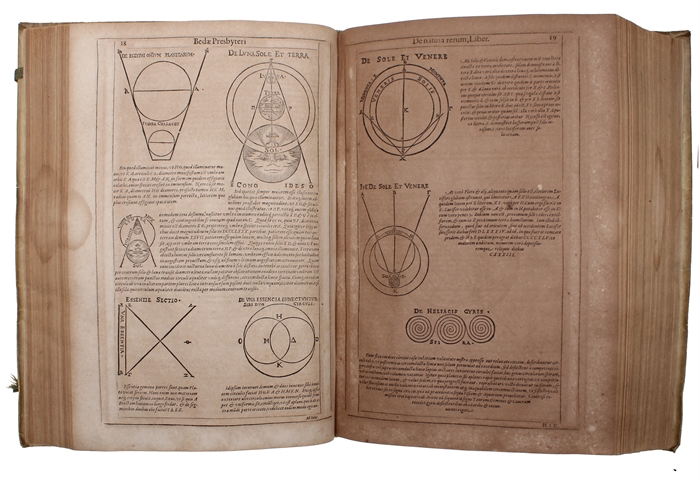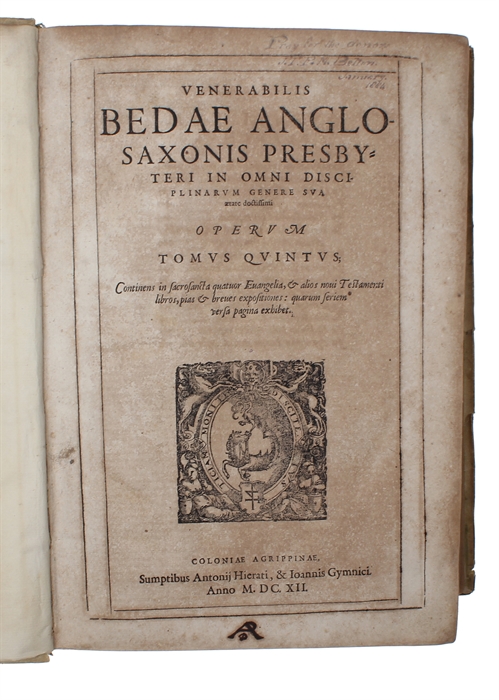THE FIRST COMPLETE BEDE
BEDE, THE VENERABLE. - BEDA.
Opera qoutquot reperiri potuerunt omnia: Hac ultima impressione ornatus in lucem edita. 8 Tomi.
Coloniae Agrippinae (Köln), Sumptibus Anton. Hierati et Ioan. Gymnici, 1612.
Folio. Bound in two contemporary, uniform full vellum bindings with remains of silk-ties on boards. Some traces of use to extremities. Some pages evenly browned, some brownspotted. First two volumes richly illustrated with woodcut diagrams, musical notes, earth- and heaven-maps etc. in the text, numerous woodcut initials throughout, engraved title-page. (10) pp, columns 1-168 (84 pp.), pp. 169 - 322, columns 323 - 452 (65 pp.) + (1) f., 238 pp. + (2) ff., columns 1 - 500 (250 pp.) + (2) ff., columns 1 - 916 (458 pp.) + (1) f., columns 1 - 816 (408 pp) + (1) f., columns 1 - 852 (426 pp.) + (2) ff., columns 1 - 485 (243 pp.) + (2) ff., columns 1 - 968 (484 pp.), 55 ff. (Index).
Very rare, early, and apparently first complete edition of the seminal works by the "Father of English History", the venrable Bede. Bede’s most famous work, his "An Ecclesiastical History of the English People" (Historia Ecclesiastica Gentis Anglorum)? begins with the invasion of the British Isles by Roman forces and is considered one of the most important historical records documenting Roman rule, Anglo-Saxon settlement and the evolution of the Church on the island. With its focus on Anglo-Saxon history, the work is considered a key foundational text in the forming of a national English identity. The "Ecclesiastical History" contains stories that serve as the only source documenting the conversion to Christianity of the Anglo-Saxon tribes. It tells the story of Britons from Julius Caesar’s invasion, to the time of Bede himself . He tells the story of battles, conversions and miracles performed by monks and bishops, and details Britain’s early history from the Roman invasion. He furthermore describes the organization and establishment of Christianity in the English church and covers the personal history of ?Holy Ethelwald and miracles of growth within the English church, such as the development of the bishopric. "Bede’s works fall into three groups: grammatical and “scientific,” scriptural commentary, and historical and biographical. His earliest works included treatises on spelling, hymns, figures of speech, verse, and epigrams. His first treatise on chronology, De temporibus (“On Times”), with a brief chronicle attached, was written in 703. In 725 he completed a greatly amplified version, De temporum ratione (“On the Reckoning of Time”), with a much longer chronicle. Both these books were mainly concerned with the reckoning of Easter. His earliest biblical commentary was probably that on the Revelation to John (703?–709); in this and many similar works, his aim was to transmit and explain relevant passages from the Fathers of the Church. Although his interpretations were mainly allegorical, treating much of the biblical text as symbolic of deeper meanings, he used some critical judgment and attempted to rationalize discrepancies. Among his most notable are his verse (705–716) and prose (before 721) lives of St. Cuthbert, bishop of Lindisfarne. These works are uncritical and abound with accounts of miracles; a more exclusively historical work is Historia abbatum (c. 725; “Lives of the Abbots”). In 731/732 Bede completed his Historia ecclesiastica. Divided into five books, it recorded events in Britain from the raids by Julius Caesar (55–54 BCE) to the arrival in Kent (597 CE) of St. Augustine of Canterbury. For his sources, he claimed the authority of ancient letters, the “traditions of our forefathers,” and his own knowledge of contemporary events. Bede’s Historia ecclesiastica leaves gaps tantalizing to secular historians. Although overloaded with the miraculous, it is the work of a scholar anxious to assess the accuracy of his sources and to record only what he regarded as trustworthy evidence. It remains an indispensable source for some of the facts and much of the feel of early Anglo-Saxon history." (Encycl. Britt). Only three editions of Bede's Opera Omnia are known before Dr. Giles' edition from 1843 - 44. The first was printed in 1563 and the third in 1688. The 1688-edition constitutes the second edition of the present 1612-edition which is "According to Dr. Henry, the only complete edition" (Lowndes I:143). These three editions are also the only ones known to have been printed in folio (though Lowndes mentions the 1688-edition as 4to). The 1612-edition is the rarest. Some of the works contained in this edition are said not to be Bede's own, as some of the many scientific, richly illustrated works on geography, the heavens, the universe, music etc. bear small resemblance to his other works. Lowndes I:143, Brunet 1:731.
Order-nr.: 28124




